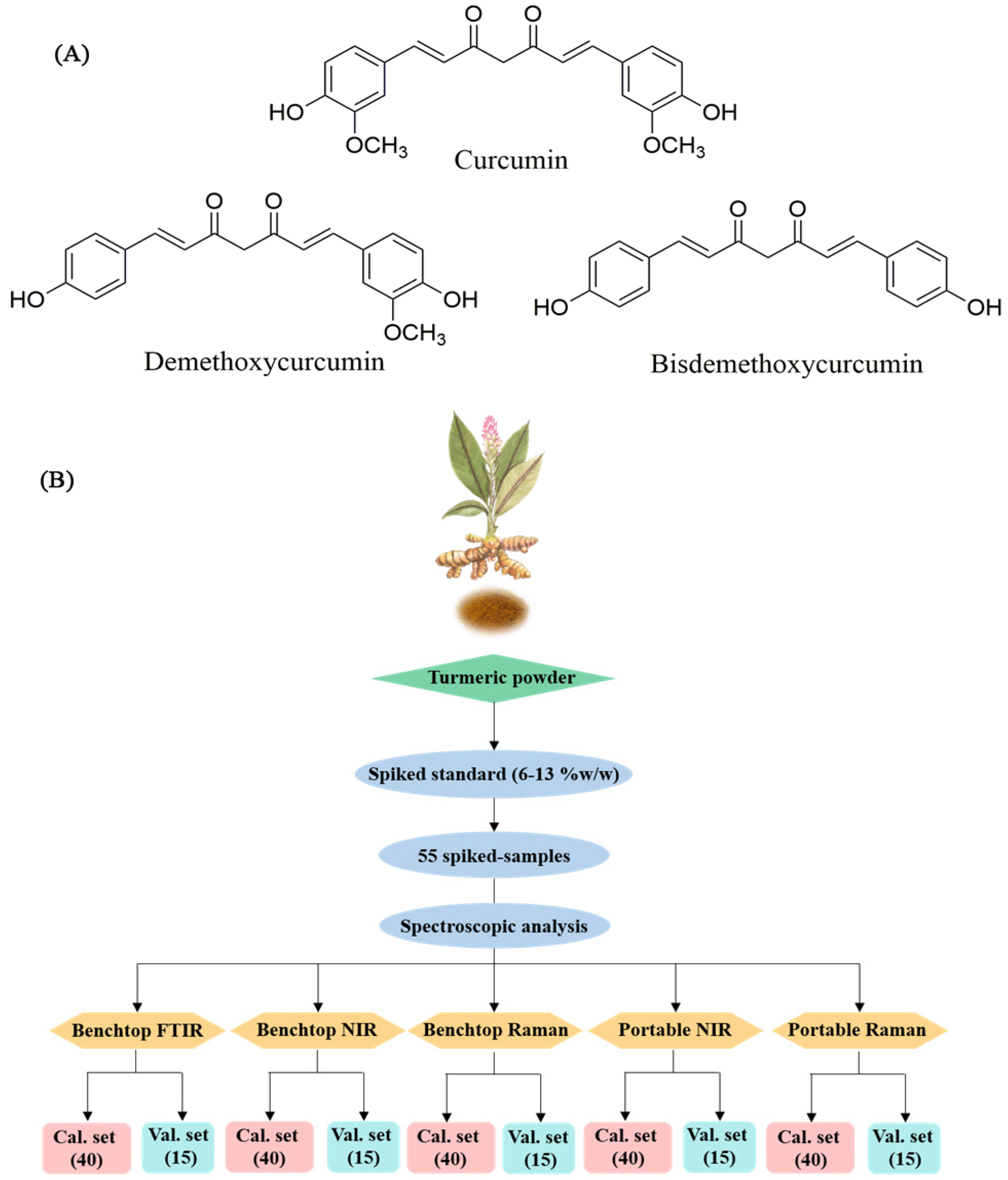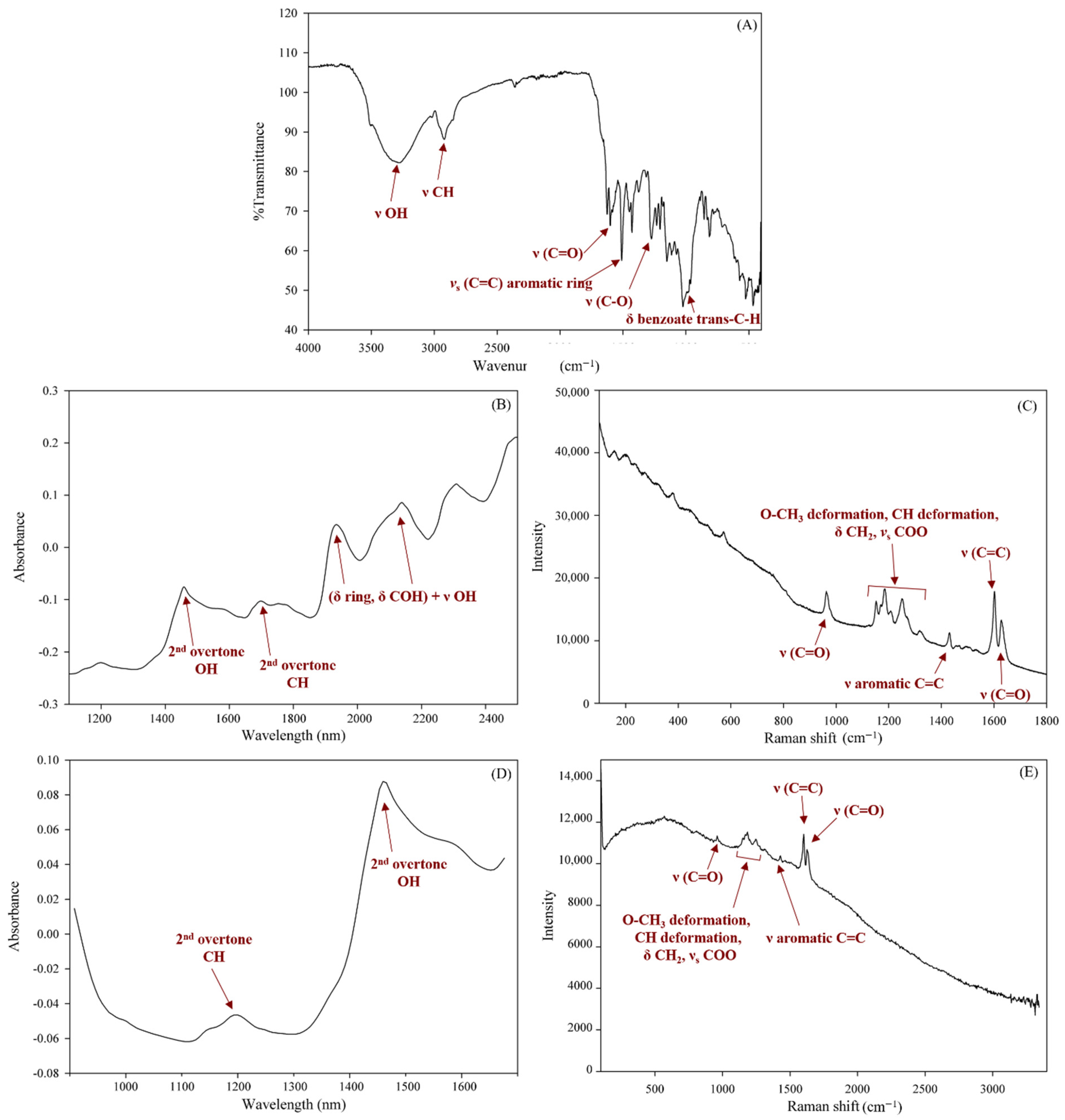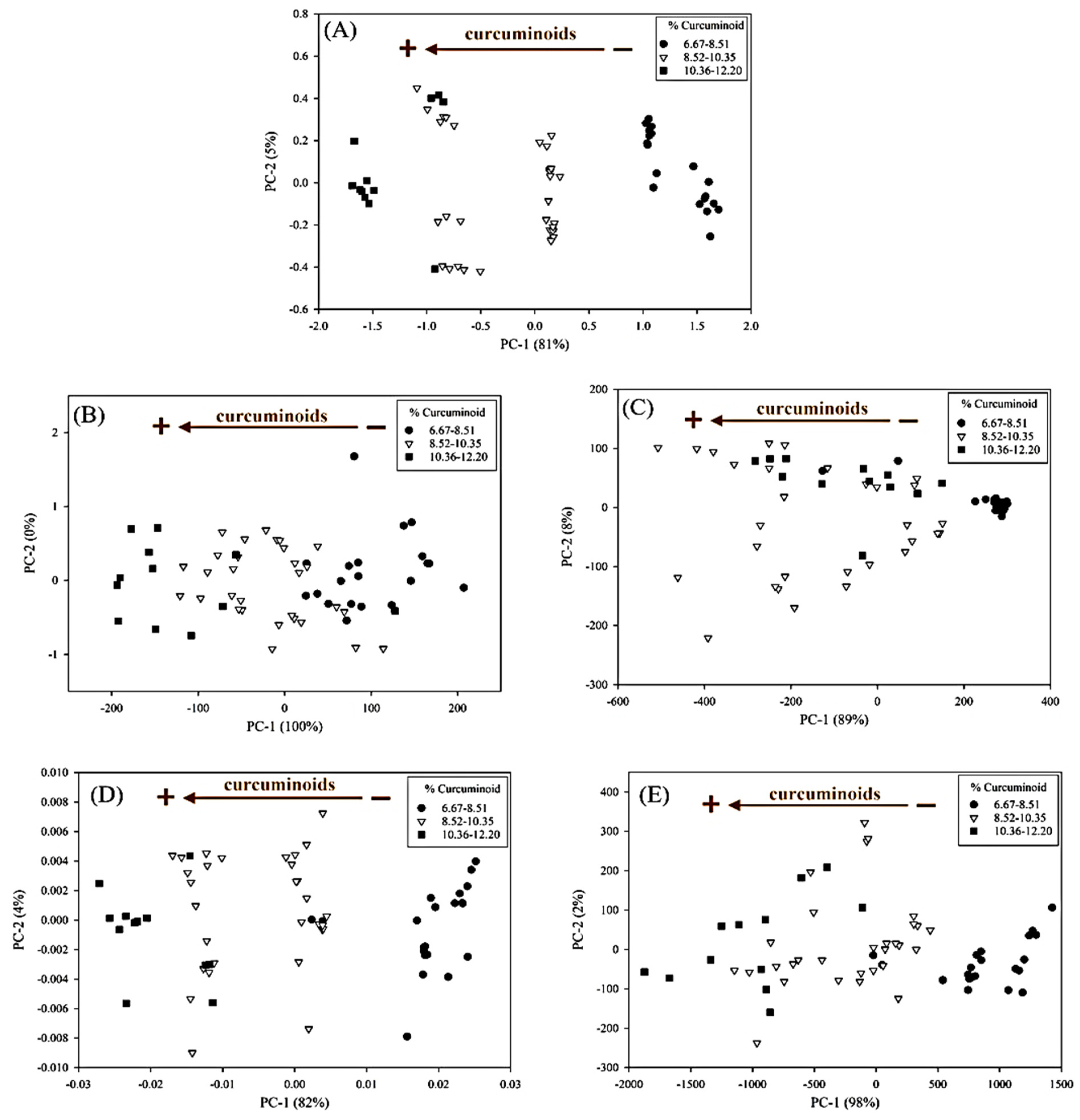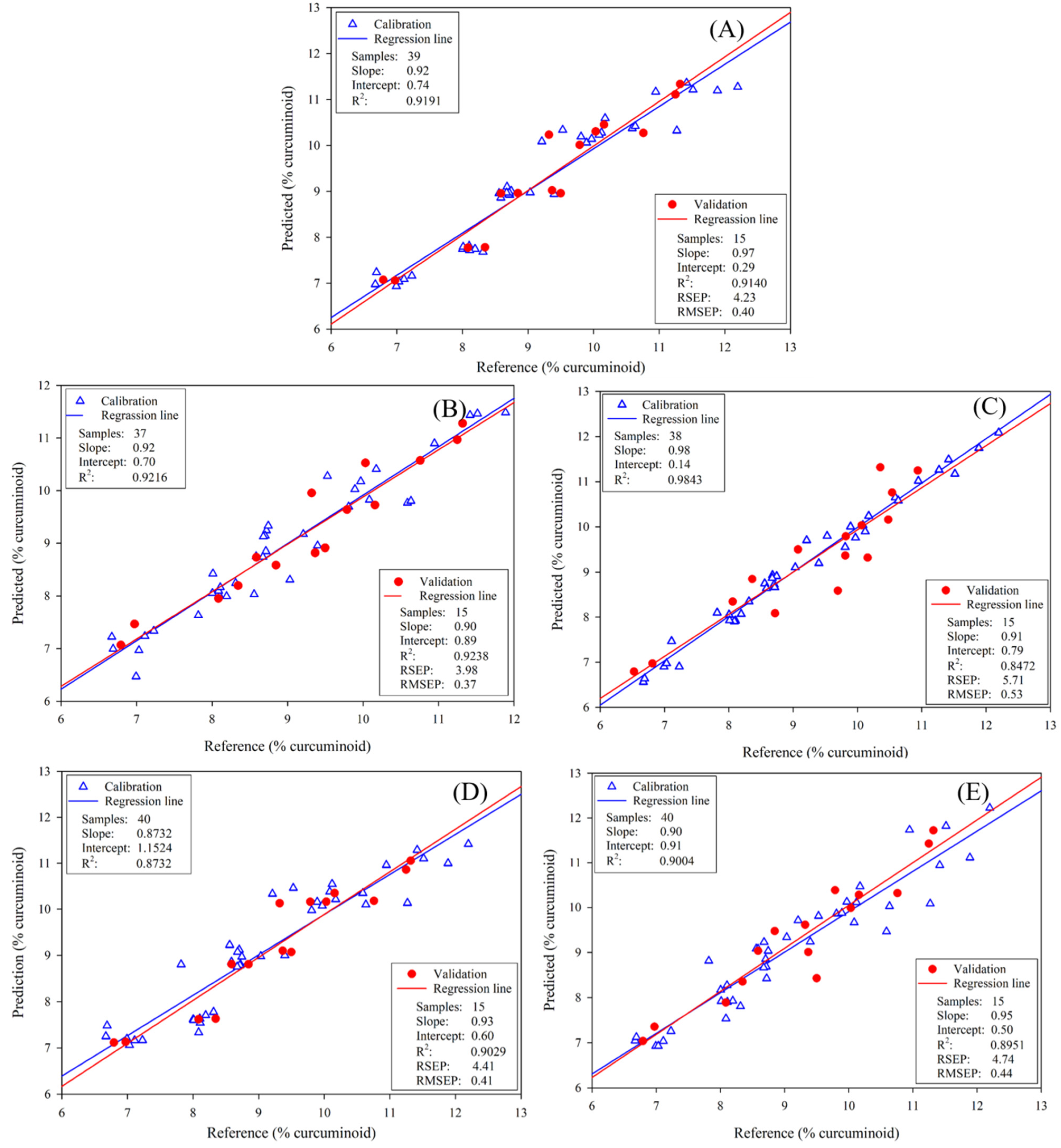A Comparative Study of Benchtop and Portable NIR and Raman Spectroscopic Methods for the Quantitative Determination of Curcuminoids in Turmeric Powder
Abstract
:1. Introduction
2. Materials and Methods
2.1. Sample Preparation
2.2. HPLC Analysis
2.3. Benchtop NIR Spectroscopy
2.4. Benchtop FT-IR Spectroscopy
2.5. Benchtop Raman Spectroscopy
2.6. Portable NIR Spectroscopy
2.7. Portable Raman Spectroscopy
2.8. PLSR Model
3. Results and Discussion
3.1. HPLC Analysis
3.2. Benchtop vs. Portable Spectroscopic Platforms
3.3. Benchtop Platforms
3.4. Portable Spectroscopic Platforms
3.5. Comparison of Benchtop and Portable Spectroscopic Platforms
4. Conclusions
Supplementary Materials
Author Contributions
Funding
Institutional Review Board Statement
Informed Consent Statement
Data Availability Statement
Conflicts of Interest
References
- Gupta, S.C.; Sung, B.; Kim, J.H.; Prasad, S.; Li, S.; Aggarwal, B.B. Multitargeting by turmeric, the golden spice: From kitchen to clinic. Mol. Nutr. Food Res. 2013, 57, 1510–1528. [Google Scholar] [CrossRef] [PubMed]
- Hatcher, H.; Planalp, R.; Cho, J.; Torti, F.M.; Torti, S.V. Curcumin: From ancient medicine to current clinical trials. Cell Mol. Life Sci. 2008, 65, 1631–1652. [Google Scholar] [CrossRef] [PubMed]
- Kharat, S.; Namdeo, A.; Mehta, P. Development and validation of HPTLC method for simultaneous estimation of curcumin and galangin in polyherbal capsule dosage form. J. Taibah Univ. Sci. 2017, 11, 775–781. [Google Scholar] [CrossRef] [Green Version]
- Jayaprakasha, G.K.; Jagan Mohan Rao, L.; Sakariah, K.K. Improved HPLC method for the determination of curcumin, demethoxycurcumin, and bisdemethoxycurcumin. J. Agric. Food Chem. 2002, 50, 3668–3672. [Google Scholar] [CrossRef] [PubMed]
- Mudge, E.; Chan, M.; Venkataraman, S.; Brown, P.N. Curcuminoids in Turmeric roots and supplements: Method optimization and validation. Food Anal. Methods 2016, 9, 1428–1435. [Google Scholar] [CrossRef] [Green Version]
- Kim, Y.J.; Lee, H.J.; Shin, Y. Optimization and validation of high-performance liquid chromatography method for individual curcuminoids in turmeric by heat-refluxed extraction. J. Agric. Food Chem. 2013, 61, 10911–10918. [Google Scholar] [CrossRef]
- Gad, H.A.; Bouzabata, A. Application of chemometrics in quality control of Turmeric (Curcuma longa) based on Ultra-violet, Fourier transform-infrared and 1H NMR spectroscopy. Food Chem. 2017, 237, 857–864. [Google Scholar] [CrossRef]
- Thai Herbal Pharmacopoeia 2018; DMSc Ministry of Public Health: Bangkok, Thailand, 2018.
- Silva-Buzanello, R.A.D.; Ferro, A.C.; Bona, E.; Cardozo-Filho, L.; Araújo, P.H.H.D.; Leimann, F.V.; Gonçalves, O.H. Validation of an ultraviolet–visible (UV–Vis) technique for the quantitative determination of curcumin in poly(l-lactic acid) nanoparticles. Food Chem. 2015, 172, 99–104. [Google Scholar] [CrossRef]
- Altunay, N.; Elik, A.; Gürkan, R. Preparation and application of alcohol based deep eutectic solvents for extraction of curcumin in food samples prior to its spectrophotometric determination. Food Chem. 2020, 310, 125933. [Google Scholar] [CrossRef]
- Dhakal, S.; Chao, K.; Schmidt, W.; Qin, J.; Kim, M.; Chan, D. Evaluation of turmeric powder adulterated with metanil yellow using FT-Raman and FT-IR spectroscopy. Foods 2016, 5, 36. [Google Scholar] [CrossRef] [Green Version]
- Chao, K.; Dhakal, S.; Schmidt, W.F.; Qin, J.; Kim, M.; Peng, Y.; Huang, Q. Raman and IR spectroscopic modality for authentication of turmeric powder. Food Chem. 2020, 320, 126567. [Google Scholar] [CrossRef] [PubMed]
- Kim, Y.J.; Lee, H.J.; Shin, H.S.; Shin, Y. Near-infrared reflectance spectroscopy as a rapid and non-destructive analysis tool for curcuminoids in turmeric. Phytochem. Anal. PCA 2014, 25, 445–452. [Google Scholar] [CrossRef] [PubMed]
- Thangavel, K.; Dhivya, K. Determination of curcumin, starch and moisture content in turmeric by Fourier transform near infrared spectroscopy (FT-NIR). Eng. Agric. Environ. Food 2019, 12, 264–269. [Google Scholar] [CrossRef]
- Praveen, A.; Prasad, D.; Mishra, S.; Nagarajan, S.; Chaudhari, S.R. Facile NMR approach for profiling curcuminoids present in turmeric. Food Chem. 2021, 341, 128646. [Google Scholar] [CrossRef] [PubMed]
- Beć, K.B.; Grabska, J.; Huck, C.W. Principles and applications of miniaturized near-infrared (NIR) spectrometers. Chem. Eur. J. 2021, 27, 1514–1532. [Google Scholar] [CrossRef]
- Crocombe, R.A. Portable spectroscopy. Appl. Spectrosc. 2018, 72, 1701–1751. [Google Scholar] [CrossRef]
- Deidda, R.; Sacre, P.-Y.; Clavaud, M.; Coïc, L.; Avohou, H.; Hubert, P.; Ziemons, E. Vibrational spectroscopy in analysis of pharmaceuticals: Critical review of innovative portable and handheld NIR and Raman spectrophotometers. TrAC-Trend. Anal. Chem. 2019, 114, 251–259. [Google Scholar] [CrossRef]
- Rukundo, I.R.; Danao, M.-G.C.; Weller, C.L.; Wehling, R.L.; Eskridge, K.M. Use of a handheld near infrared spectrometer and partial least squares regression to quantify metanil yellow adulteration in turmeric powder. J. Near. Infrared Spectrosc. 2020, 28, 81–92. [Google Scholar] [CrossRef]
- Wirasuta, I.M.A.G.; Dewi, C.I.T.R.; Laksmiani, N.P.L.; Srinadi, G.A.M.; Putra, D.P. The prediction of curcumin in the turmeric rhizome with Raman handheld spectroscopy. IJPST 2018, 5, 88–92. [Google Scholar] [CrossRef]
- Wichitnithad, W.; Jongaroonngamsang, N.; Pummangura, S.; Rojsitthisak, P. A simple isocratic HPLC method for the simultaneous determination of curcuminoids in commercial turmeric extracts. Phytochem. Anal. PCA 2009, 20, 314–319. [Google Scholar] [CrossRef]
- Losso, K.; Bec, K.B.; Mayr, S.; Grabska, J.; Stuppner, S.; Jones, M.; Jakschitz, T.; Rainer, M.; Bonn, G.K.; Huck, C.W. Rapid discrimination of Curcuma longa and Curcuma xanthorrhiza using direct analysis in real time mass spectrometry and near infrared spectroscopy. Spectrochim. Acta A Mol. Biomol. Spectrosc. 2022, 265, 120347. [Google Scholar] [CrossRef] [PubMed]
- Pawar, H. Phytochemical evaluation and curcumin content determination of turmeric rhizomes collected from Bhandara district of Maharashtra (India). Med. Chem. 2014, 4, 588–591. [Google Scholar] [CrossRef] [Green Version]
- Fearn, T. On orthogonal signal correction. Chemom. Intell. Lab. Syst. 2000, 50, 47–52. [Google Scholar] [CrossRef]
- Alcalà, M.; Blanco, M.; Moyano, D.; Broad, N.W.; O’Brien, N.; Friedrich, D.; Pfeifer, F.; Siesler, H.W. Qualitative and quantitative pharmaceutical analysis with a novel hand-held miniature near infrared spectrometer. J. Near Infrared Spectrosc. 2013, 21, 445–457. [Google Scholar] [CrossRef] [Green Version]
- Correia, R.M.; Domingos, E.; Tosato, F.; dos Santos, N.A.; Leite, J.d.A.; da Silva, M.; Marcelo, M.C.A.; Ortiz, R.S.; Filgueiras, P.R.; Romão, W. Portable near infrared spectroscopy applied to abuse drugs and medicine analyses. Anal. Methods 2018, 10, 593–603. [Google Scholar] [CrossRef]
- Sun, L.; Hsiung, C.; Pederson, C.G.; Zou, P.; Smith, V.; von Gunten, M.; O’Brien, N.A. Pharmaceutical raw material identification using miniature near-infrared (microNIR) spectroscopy and supervised pattern recognition using support vector machine. Appl. Spectrosc. 2016, 70, 816–825. [Google Scholar] [CrossRef] [PubMed] [Green Version]
- Pu, Y.; Pérez-Marín, D.; O’Shea, N.; Garrido-Varo, A. Recent advances in portable and handheld NIR spectrometers and applications in milk, cheese and dairy powders. Foods 2021, 10, 2377. [Google Scholar] [CrossRef]
- Grabska, J.; Bec, K.B.; Huck, C.W. Novel near-infrared and Raman spectroscopic technologies for print and photography identification, classification, and authentication. NIR News 2021, 32, 11–16. [Google Scholar] [CrossRef]




| Specificity | |||
|---|---|---|---|
| Name | Retention Time (min) | Resolution * | Peak Purity (%) * |
| Standard | |||
| bisdemethoxycurcumin | 6.26 | - | 98.7 |
| demethoxycurcumin | 6.94 | 2.4 | 99.0 |
| curcumin | 7.70 | 2.5 | 98.9 |
| Turmeric sample | |||
| bisdemethoxycurcumin | 6.27 | - | 96.0 |
| demethoxycurcumin | 6.95 | 2.5 | 97.8 |
| curcumin | 7.70 | 2.4 | 97.1 |
| t-test (p-value > 0.05) | 0.99 | ||
| Linearity | |||
| Linear equation | y = 130,514x − 640,682 | ||
| Correlation coefficient (r) ** | 0.9999 | ||
| Accuracy (%recovery ± SD) *** | |||
| Curcuminoid spiked concentrations | Repeatability (n = 3) | Intermediate precision (n = 3) | |
| 5 μg/mL | 101.0 ± 0.7 | 100.7 ± 0.6 | |
| 35 μg/mL | 101.5 ± 1.3 | 100.0 ± 1.6 | |
| 74 μg/mL | 100.2 ± 0.2 | 99.2 ± 1.0 | |
| Precision (%RSD) **** | 1.0 | 0.8 | |
| Model Parameters | Spectroscopic Method | ||||
|---|---|---|---|---|---|
| Benchtop NIR | Benchtop FT-IR | Benchtop Raman | Portable NIR | Portable Raman | |
| Spectral region | 1854–2260 nm | 766–1687 cm−1 | 840–1799 cm−1 | 970–1645 nm | 1536–1696 cm−1 |
| Pre-treatment | SNV + 2D(11p) | OSC 2 factors | Smoothing + BLC + OSC 1 factor | SNV + 2D(7p) | MA(5p) +BLC |
| PLS factors | 1 | 1 | 3 | 1 | 3 |
| Explained variance (%) | 92 | 92 | 98 | 87 | 90 |
| Calibration samples | 39 | 37 | 38 | 40 | 40 |
| Intercept | 0.74 | 0.70 | 0.14 | 1.15 | 0.91 |
| Slope | 0.92 | 0.92 | 0.98 | 0.87 | 0.90 |
| R2 model | 0.9191 | 0.9216 | 0.9843 | 0.8700 | 0.9004 |
| RMSEC | 0.4143 | 0.3792 | 0.1851 | 0.5175 | 0.4587 |
| Diameter of the measurement area | N/A | 1.8 mm | 3.8 µm | 30 mm | 85 µm |
| Method performance | |||||
| R2 (pearson) | 0.9140 | 0.9238 | 0.8472 | 0.9029 | 0.8951 |
| RSEP (%) | 4.227 | 3.983 | 5.713 | 4.404 | 4.739 |
| RMSEP | 0.396 | 0.373 | 0.535 | 0.413 | 0.444 |
| Bias | −0.011 | 0.046 | −0.020 | 0.063 | −0.081 |
| tcrit | 2.14 | 2.14 | 2.14 | 2.14 | 2.14 |
| texp | 0.009 | 0.041 | 0.017 | 0.054 | 0.067 |
| Statistical Evaluation | Spectroscopic Method | |
|---|---|---|
| ANOVA | All methods-FT-IR, NIR, Raman | |
| F-experimental | F-critic | |
| 0.012 | 2.5 | |
| Comparison of variances (F-Test) | Raman benchtop and micro Raman | |
| F-experimental | F-critic | |
| 0.391 | 2.98 | |
| NIR Benchtop and micro NIR | ||
| F-experimental | F-critic | |
| 1.079 | 2.98 | |
| Comparison of means (t-Test) | Raman benchtop and micro Raman | |
| t-experimental | t-critic | |
| 0.103 | 2.14 | |
| NIR benchtop and micro NIR | ||
| t-experimental | t-critic | |
| 0.173 | 2.14 | |
Publisher’s Note: MDPI stays neutral with regard to jurisdictional claims in published maps and institutional affiliations. |
© 2022 by the authors. Licensee MDPI, Basel, Switzerland. This article is an open access article distributed under the terms and conditions of the Creative Commons Attribution (CC BY) license (https://creativecommons.org/licenses/by/4.0/).
Share and Cite
Khongkaew, P.; Cruz, J.; Bertotto, J.P.; Cárdenas, V.; Alcalà, M.; Nuchtavorn, N.; Phechkrajang, C. A Comparative Study of Benchtop and Portable NIR and Raman Spectroscopic Methods for the Quantitative Determination of Curcuminoids in Turmeric Powder. Foods 2022, 11, 2187. https://doi.org/10.3390/foods11152187
Khongkaew P, Cruz J, Bertotto JP, Cárdenas V, Alcalà M, Nuchtavorn N, Phechkrajang C. A Comparative Study of Benchtop and Portable NIR and Raman Spectroscopic Methods for the Quantitative Determination of Curcuminoids in Turmeric Powder. Foods. 2022; 11(15):2187. https://doi.org/10.3390/foods11152187
Chicago/Turabian StyleKhongkaew, Putthiporn, Jordi Cruz, Judit Puig Bertotto, Vanessa Cárdenas, Manel Alcalà, Nantana Nuchtavorn, and Chutima Phechkrajang. 2022. "A Comparative Study of Benchtop and Portable NIR and Raman Spectroscopic Methods for the Quantitative Determination of Curcuminoids in Turmeric Powder" Foods 11, no. 15: 2187. https://doi.org/10.3390/foods11152187
APA StyleKhongkaew, P., Cruz, J., Bertotto, J. P., Cárdenas, V., Alcalà, M., Nuchtavorn, N., & Phechkrajang, C. (2022). A Comparative Study of Benchtop and Portable NIR and Raman Spectroscopic Methods for the Quantitative Determination of Curcuminoids in Turmeric Powder. Foods, 11(15), 2187. https://doi.org/10.3390/foods11152187






